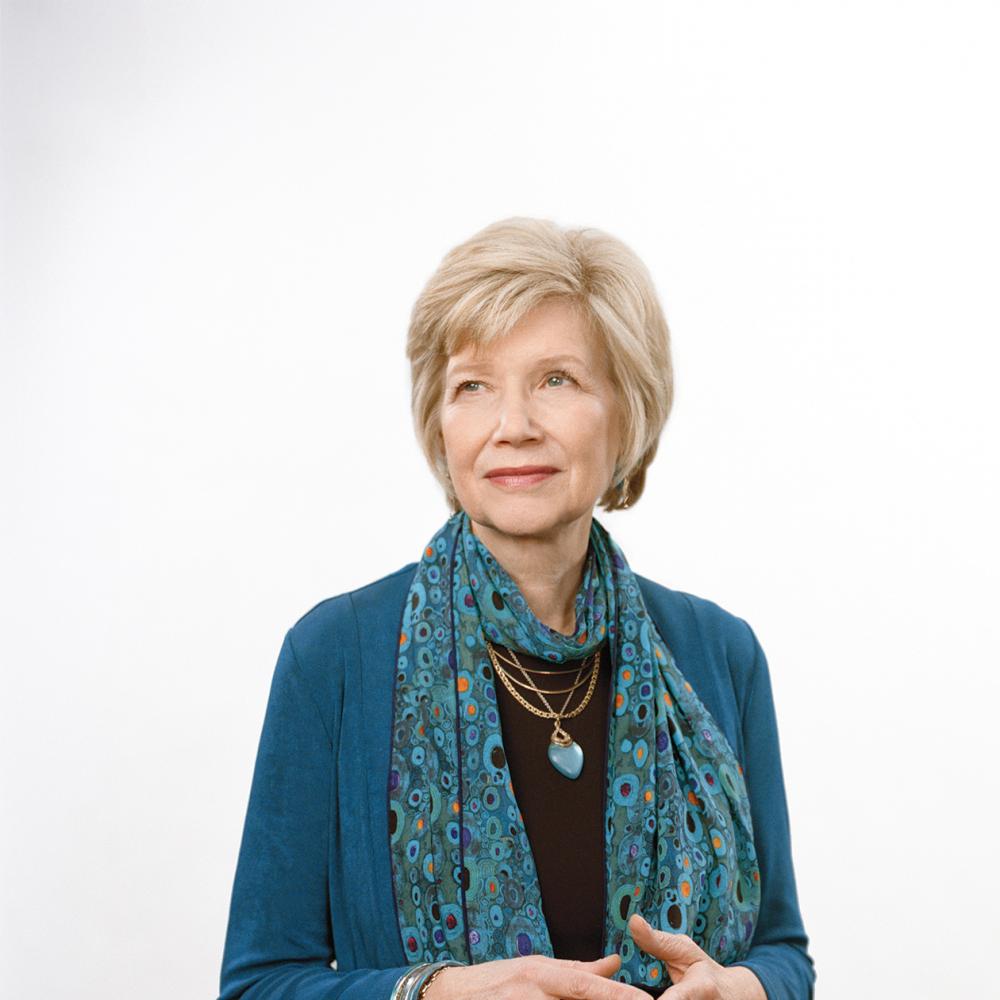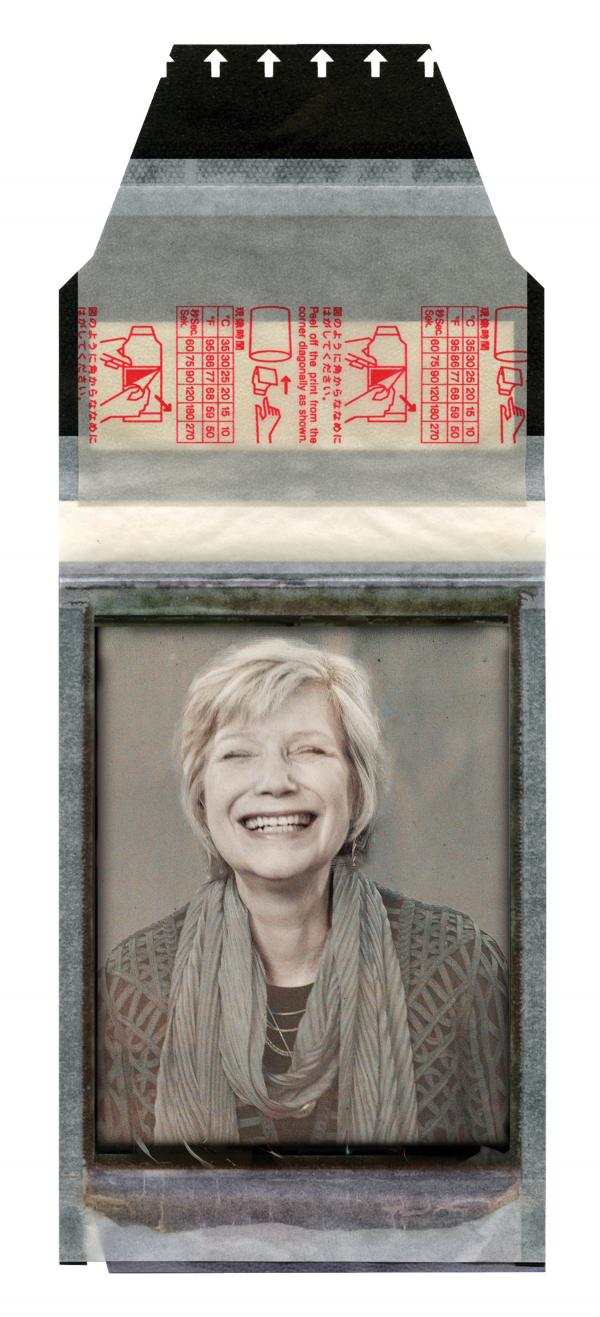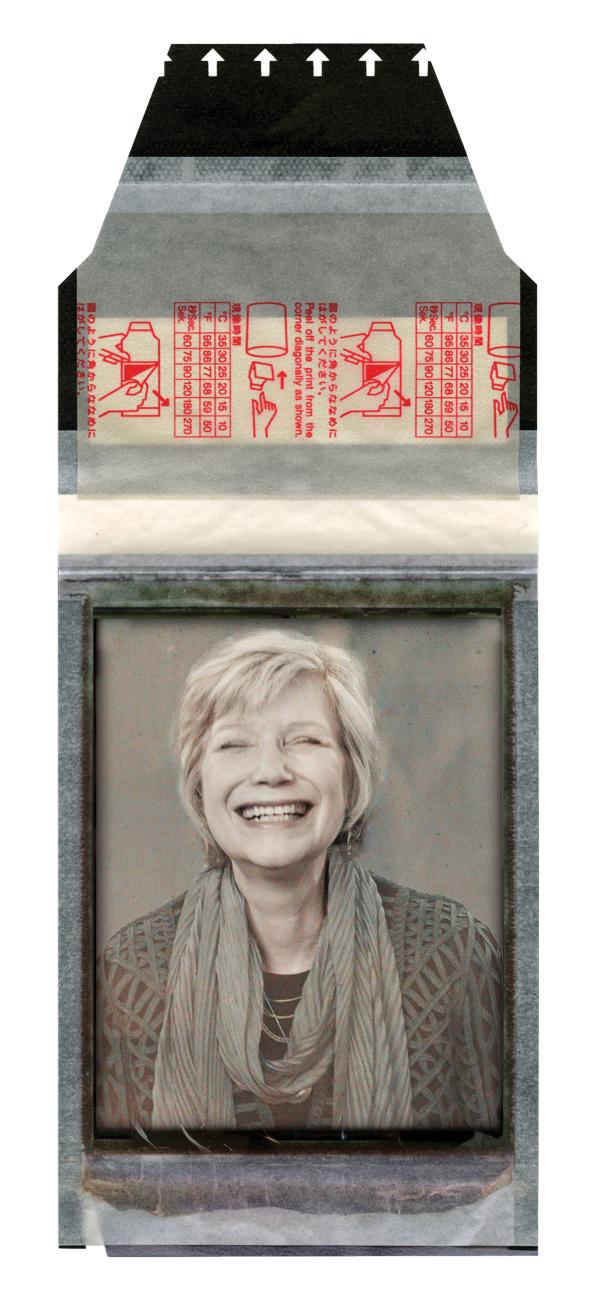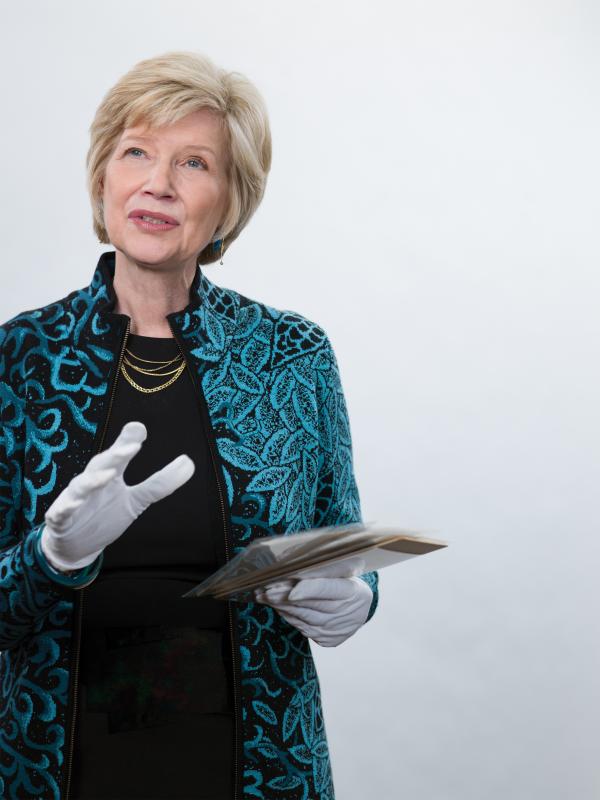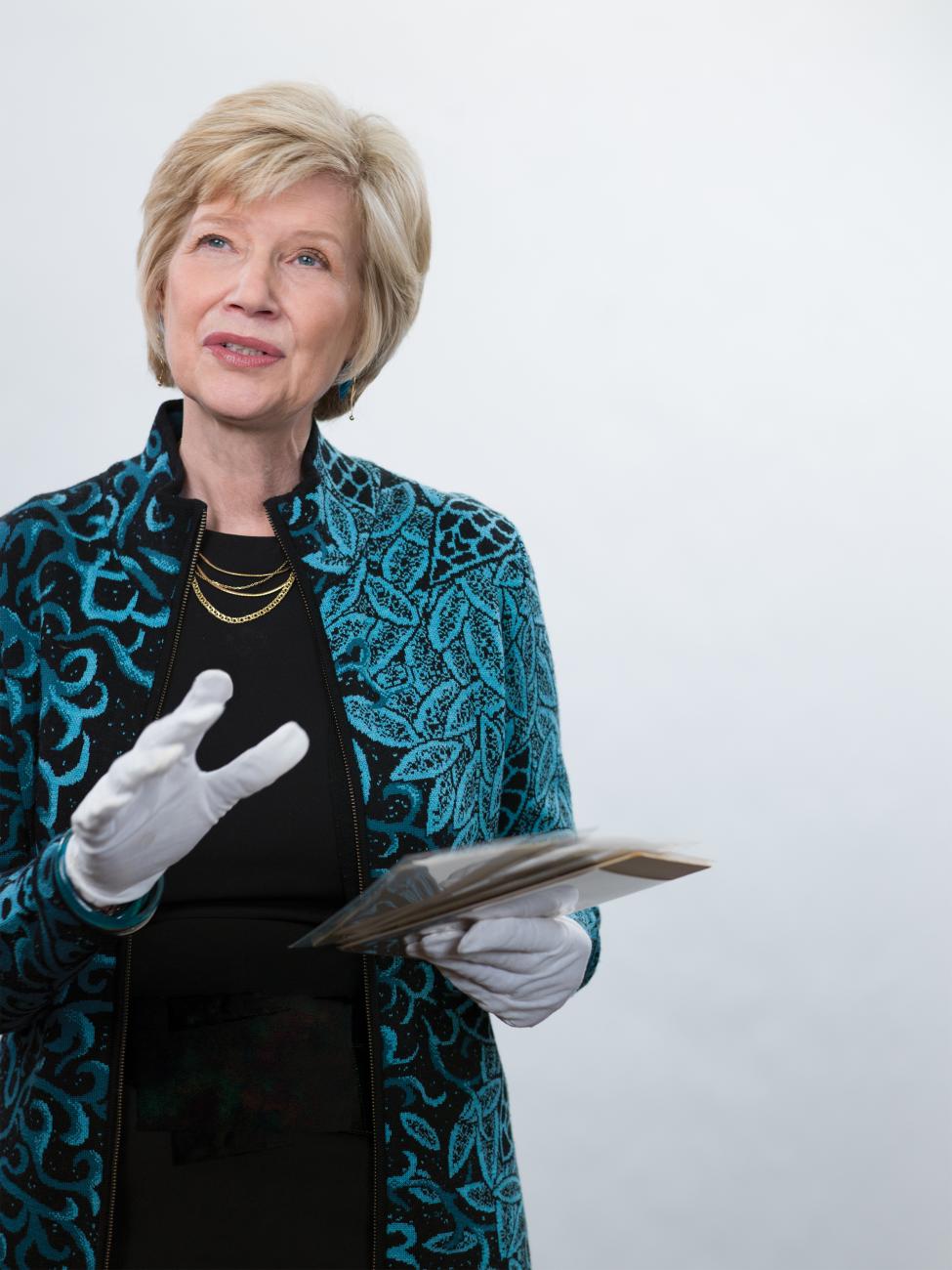On January 4, 2016, the first day of her introductory graduate course on photographic preservation at the University of Delaware, Professor Debra Hess Norris carried a box of 275 damaged photographs into the conservation laboratory at Winterthur Museum, Garden and Library.
The photos had arrived by mail from the central Texas town of Wimberley. Over the previous Memorial Day weekend, Wimberley had experienced rain and flooding on a biblical scale. In a matter of hours, the Blanco River crested at 43 feet—30 feet above flood stage—the highest in recorded history. Hundreds of homes were swept away as a wall of water moving twice as fast as Niagara Falls pushed downstream. Thirteen people were killed, thousands displaced.
As the floodwaters receded and residents searched through the wreckage, they found photographs—thousands of them—orphaned by the storm, scattered among debris, covered in silt, cockled from water exposure. As word of the orphaned photos spread, the Wimberley Village Library went into crisis mode and set up a lost and found for the photos to be dried, cleaned, and cataloged until claimed by their rightful owners.
When Norris heard of the efforts to save what amounted to more than eight thousand photos of families, weddings, newborn babies, and birthday parties, she reached out to her friend and colleague Karen Pavelka, photograph conservator at the University of Texas at Austin, to ask if she could help.
“I heard that you have been very active in responding to the recent and terrible floods in Texas,” Norris wrote in an email. “If you can think of any way that we can help, please let us know.”
Pavelka connected Norris to Amy Bowman, a UT archivist on the ground at Wimberley, who was helping organize recovery efforts.
“My focus in Wimberley has been helping the library reunite photos with their owners—many of [the photos] were washed miles down the river,” wrote Bowman. “Would you be willing to work on these, even though we’re not sure who they belong to?”
Of course, said Norris. “I think it is so important for the public to know that there are professionals who can assist with emergency response and recovery following a disaster—that damaged family treasures can be saved and that there is some hope.”
If Norris has a guiding creed, it’s hope. In the darkest hours, she believes in the possibility of salvation and goes about saving things. Her kind of hope is a powerful, relentless, and infectious optimism that even gives hope to others.
It’s been said that half of all photograph conservators in the United States have been trained by Norris in her decades-long career as a professor of photograph conservation at the University of Delaware, where she is also the Unidel Henry Francis du Pont Chair in Fine Arts and director of the Winterthur/University of Delaware Program in Art Conservation, one of only four art conservation graduate programs in the nation. Graduates from the Delaware program have conserved some of the most significant artifacts from our shared cultural heritage, including the Declaration of Independence, the Star-Spangled Banner, the Emancipation Proclamation, Babe Ruth’s baseball contract, Elvis Presley’s 81 gold records, the ruby slippers from The Wizard of Oz, Polaroid photographs by Andy Warhol, the Treaty of Paris, the Dead Sea Scrolls, the original C-3PO from the movie Star Wars, the 1905 Wright Flyer III, George Washington’s dentures and—perhaps most importantly for Norris, a lifelong Beatles fan—a rare photo album of the Beatles from 1961 to 1963.
Norris has also traveled the world organizing training programs to preserve cultural heritage. She’s taught workshops in dozens of countries on every continent except Antarctica, and in doing so has become a global leader in the fight to preserve cultural heritage.
In 2009, as Iraq slowly emerged from years of sectarian violence, Norris worked closely with the U.S. Department of State and the Coalition Provisional Authority to develop the Iraqi Institute for the Conservation of Antiquities and Heritage, a program in Erbil, which, among other things, trained in the excavation of mass graves. In 2014 and 2015, as ISIS rampaged across Iraq and Syria, Norris traveled to Jordan and Lebanon, respectively, to host workshops as part of the Middle East Photograph Preservation Initiative. Just two months after Hurricane Matthew battered Cuba in 2016, Norris was in Havana, holding workshops to train conservators on how to restore photographs damaged by floodwaters. Since 1997, she has secured over $20 million in external grants, including almost $2.5 million from the National Endowment for the Humanities, to fund conservation efforts worldwide.
The list goes on. Her curriculum vitae is 27 pages of very small print.
“She doesn’t show stress,” says Joyce Hill Stoner, professor and painting conservator at the University of Delaware. “She’s usually too busy calming other people down. That’s why she doesn’t lose her calm. It is typical that extreme amounts of photo archives are part of the disaster. She’s trained to manage horrendous situations.”
Last year, Norris won the Francis Alison Award, the highest honor given to faculty at the University of Delaware, thanks in part to letters of support that arrived from far and wide. “During my 34-year career as an art conservator, no one has contributed more to the advancement of art-conservation education and awareness around the world than Debbie,” wrote Marc Harnly, senior conservator and head of the department of paper conservation at the J. Paul Getty Museum. “Arguably the best-known conservator in the world, she has made it her mission to take her skill as an educator to the furthest corners of the planet.”
“She has done more to save world heritage, in my opinion, than any other conservator, professor or foundation,” wrote Anne-Imelda Radice, then executive director at the American Folk Art Museum (and currently the director of Public Programs at NEH). “To me she has always been a force of nature.”
“Indeed,” wrote Nora W. Kennedy, photo conservator at the Metropolitan Museum of Art, “she gives her heart and her soul for the betterment of humankind altogether. There is no cause too small and no cause too massive—if it will achieve good, she commits to it and sees it through to the successful conclusion.”
The need for this global leadership has never been more urgent, for the cultural heritage of every nation is threatened by climate change, conflict, political division or just downright neglect. The planet is embroiled in crises. Things really do fall apart. Last September, Brazil lost 20 million artifacts documenting 12,000 years of history in just six hours to fire.
In the midst of it all, with her gentle smile, steely determination, penchant for the color teal and enthusiasm for the Beatles, Norris remains steadfast in her lifelong quest to train a global cadre of conservators to protect our global cultural heritage from the ash heap of history.
Photo conservation is a numbers game. There are billions of photographic prints and negatives worldwide (the Library of Congress holds a paltry 15 million), many of which are threatened by neglect or poor preservation practices. The challenges of preserving this heritage are immense.
“A painting conservator works with one painting for a long time,” says Professor Stoner, as we tour the conservation labs at Winterthur, pointing to one painting that had been slashed with a knife. “Whereas a photo conservator gets a call that says we’ve just had thirty thousand glass-plate negatives under water during a hurricane.”
When Norris was admitted as a graduate student to the art conservation program at the University of Delaware in 1977, photo conservation was a nascent field, consisting of a mere handful of professionals in the early stages of documenting best practices for preserving photographic media.
Equal parts humanist and scientist, photo conservators must possess a firm grasp of the chemistry that transforms immaterial light and shade into material images. The majority of photographic prints are multilayered artifacts, consisting of a support, like paper or metal, which is coated with a binding agent that suspends upwards of seven additional layers of light-sensitive materials, like silver nitrate or colored pigments, with the number of layers multiplying as photography moved from monochrome to full color.
Depending on the materials used, different kinds of photographic prints deteriorate in markedly dissimilar ways. During the nineteenth century, three of the most widely used photographic materials were albumen, collodion, and gelatin prints. In the albumen process, egg white that has been whipped and strained holds silver salts in suspension and is coated onto a light-weight paper support. Albumen prints were popular, but after a few years, as the organic compounds in the albumen degrade and the silver image is oxidized, the photograph turns yellow and fades. In the late nineteenth century, collodion prints reduced exposure time and were not as prone to yellowing as the albumen prints; however, the binding layer was brittle and easily abraded. Near the end of the century, photographers also used gelatin prints, which tend to absorb moisture, causing the gelatin to swell, become tacky, and susceptible to mold.
Photo conservators must understand the minute details of myriad photographic processes as well as appropriate preservation techniques for each. Alcohol, for example, can be used to clean gelatin prints but will destroy collodion.
The first generation of photo conservators was still figuring all this out when Norris graduated with a master’s in 1980. Many of those early photograph conservators were initially trained in paper conservation, as was Norris’s mentor, José Orraca, who was hired by the University of Delaware to design and implement its graduate-level curriculum in photo conservation.
When Orraca left the university in 1982, Norris was asked to teach the introductory graduate course on photo preservation, a requirement for all students enrolled in the art conservation program. Even with a ten-day-old child at home, Norris happily accepted. It was a dream come true.
The university hired her full-time in 1986, and she’s taught that same introductory course nearly every year since, exposing hundreds of students not only to best practices in photo conservation but also to the other great inspiration in her life, the Beatles.
Norris doesn’t just love the Beatles, as is evidenced by the extensive memorabilia throughout her office. It would be more accurate to say that she embodies the Beatles. She saw the Fab Four live for the first time on August 16, 1966, at John F. Kennedy Stadium in Philadelphia. To this day, she wears a bracelet bearing the lyrics of the late John Lennon, “You may say I’m a dreamer, but I’m not the only one.”
“Dad always imagined I would grow out of it,” she giggles while telling me about the most recent Paul McCartney concert she attended. “But I never did!”
There’s something strangely prophetic about the world’s leading photo conservator developing a lifelong obsession with what is often called the world’s most photographed band, an irony that’s not lost to Norris.
“I always loved photographs,” she says, noting the sentimental relationship between photos and human memory. “I certainly spend a lot of time looking at photographs of the Beatles.”
Like the Beatles, who helped inspire a generation to embrace love and peace in the face of war and violence, Norris has inspired a global cadre of believers to foster an ethic of care and preservation amidst destruction and waste.
She has expanded the ranks of conservators at home and abroad through hundreds of workshops, seminars, and conference presentations, often bearing titles that incorporate her favorite lyrics. “All You Need Is Love? The Preservation of our Global Photographic Heritage” in Brussels; “The Long and Winding Road: Prioritizing the Preservation Needs of Photograph Collections” at Tokyo Polytechnic University; “Help! The Preservation of Family Photographs” at the Croatian National Archives in Zagreb; and this hearty amalgamation, “It Won’t Be Long: The Preservation of Our Photographic Heritage With a Little Help from My Friends . . . Just Imagine” at Trinity College Library in Dublin.
“There’s so much work to be done that you need to empower every single person around you to go in there and do what they think needs to be done, and my opportunity is trying to find resources to make that happen,” says Norris. “This is not a field for micromanagers.”
As president of the American Institute for Conservation (AIC) in the mid 1990s, Norris made it a priority to cultivate relationships and expand training opportunities for conservators in Latin America. At a meeting of the International Council of Museums in Scotland, she met Amparo Rueda, vice president and secretary of the Association for Heritage Preservation of the Americas. Over lunch, Rueda conveyed to Norris the importance of bringing Latin American conservators to AIC conferences.
“I think it is important for the conservators in the U.S. and Canada to hear what people in Latin America have to say,” Rueda recalls saying to Norris. “Everything in Latin America is a lot more difficult than in the U.S. because, in Latin America, the budgets are so much reduced. They have to really fight hard to accomplish something.”
On the spot, Norris agreed, and she soon thereafter submitted a grant to the Getty Foundation on behalf of the AIC to fund the initiative. Because of that initial step, 20 years later, more than 285 Latin American conservators have received grants to attend AIC conferences. Norris has since collaborated with Rueda to bring training workshops to Havana, Cuba, and Bogota, Colombia, where one awestruck student from Chile remarked, “Debbie, you are my Paul McCartney!”
In nations with few, if any, photo conservators, the impact of even a single conservation workshop can be game-changing. Last year, Norris participated in a five-day preservation workshop in Cape Town, South Africa. Angela Zehnder, painting conservator at the Iziko South African National Gallery, had met Debbie two years earlier during a two-day workshop at the University of Pretoria. Given the lack of trained photo conservators in South Africa, the workshop was attended mostly by professional photographers interested in preserving their own private collections.
“People would come to these workshops, and within fifteen minutes they’d be absolutely spellbound,” says Zehnder. “She has a gift, an extraordinary gift. She’s very dynamic. She always makes it funny and includes music. And at the same time you’re having fun, you’re actually learning a crazy amount of knowledge.”
In Iraq, Norris collaborated with the Department of State and the Coalition Provisional Authority to develop curriculum and funding mechanisms for the Iraqi Institute for the Conservation of Antiquities and Heritage (IICAH), which since 2009 has trained more than 500 conservators.
The institute was guided from its inception by John Russell, professor of art history at the Massachusetts School of Art and Design in Boston. Russell remembers one particularly difficult “make or break” moment for IICAH. In December 2010, funding was set to expire and there was little appetite at the U.S. Embassy in Baghdad to extend the funding.
“The role of public diplomacy in the State Department is to basically promote American values and values that are consistent with democratic ideals,” says Russell. “What was happening there had not happened before, either here or elsewhere in the Middle East.”
When Russell learned that the embassy was going to send a high-level delegation to Erbil to examine the institute before shutting it down, he contacted Norris and urged her to fly to Erbil to help advocate for the initiative. She wasn’t on the next flight, but it was pretty close.
According to Russell, the delegation saw what was happening at the institute and called it a miracle. “I don’t think that would have happened without Debbie coming over on short notice and speaking up for these programs. When she speaks, people listen.”
On the spot, the delegation agreed to fund the institute for another year, pending the completion of a grant application and a formal agreement with a U.S. institution to administer the funds. (Norris volunteered the University of Delaware and wrote a $580,000 grant over winter break.) Since then, the institute has received more than $3.5 million in grant funding to support its programs.
“Without Debbie,” says Russell, “the IICAH would long ago have ceased to exist.”
At approximately the same time, Norris cofounded the Middle East Photograph Preservation Initiative (MEPPI), which from 2009 until last year has trained more than 70 photo conservators, representing 52 cultural institutions in fifteen countries across the Middle East and North Africa.
Norris recalls that she was reviewing grant applications for the Getty when she thought of her close friend Nora W. Kennedy, who was born and raised in Beirut and frequently spoke of the need for more photo conservators across the region. When Norris and Kennedy later discussed the possibility of holding a pilot workshop in Lebanon, they realized they would need a partner in the region to act as the logistical hub. They pitched the idea to Zeina Arida, who at the time served as director of the Arab Image Foundation, and she was immediately on board.
For conservators who have attended MEPPI workshops, the program isn’t just a curriculum. Over the past ten years, it’s become more like a family. Maha Ahmed, senior photograph conservator at Cairo University, met Norris during a five-day MEPPI workshop in Rabat, Morocco, in 2012. Ahmed recalls boarding a bus for a day trip to Marrakesh. Norris played “Twist and Shout” on her cell phone and proceeded to, of course, twist and shout.
Two years later at a MEPPI workshop in Amman, Jordan, Ahmed conveyed to Norris her difficulty teaching photo conservation because she lacked material prints for the class to examine. This is problematic because it’s difficult to learn how to distinguish between albumen, collodion, and gelatin prints from a Power-Point presentation. You need to hold the prints in your hands, she explains, to see the yellowing in the albumen or cracks in the collodion. At the end of the workshop, Norris gifted Ahmed the photos used in the workshop.
Another MEPPI collaborator, Kaoukab Chebaro, who was the Associate University Librarian for Archives and Special Collections, American University of Beirut Libraries, and currently the Head of Global Studies at Columbia University Libraries, has worked closely with Norris for over a decade developing training curriculums and workshops. Norris recently helped Chebaro raise funds for a photo conservation lab at AUB.
“She’s a real embodiment of what the humanities are, this global outreach and sensitivity to human values and cultural heritage—bridging cultures, bridging regions,” says Chebaro. “There is something about her presence, and her style, the way she does it, which exudes human warmth and belief in humanity.”
On January 5, 2015, Norris arrived on the first day of class with a box of two hundred eighty damaged photos. When she opened the box, the acrid smell of smoke permeated the room. As she and her students proceeded to examine the photos, the faces of three young boys looked back at them. The photos had just arrived from Fayette County, Ohio, a rural exurb about halfway between Cincinnati and Columbus, and were charred, burned black around the edges, and wrinkled from water exposure.
For Ricky Harris, looking at photos of his sons had always been difficult. But looking at the photos became even more difficult after the house fire that claimed the lives of his three boys, Kenyon, 14, Broderick, 11, and Braylon, 9, and his mother, Terry, 60.
The boys hadn’t wanted their grandmother to spend Christmas night alone. They adored her. She lived just two doors down on the same side of the street. They were at her house all the time. Around four o’clock in the morning, a fire caused by a propane leak engulfed the home. When the fire department arrived four minutes after the first 911 calls, the home had partially collapsed.
“We ran down there, and it was like a bad dream.” Harris recalled to UDaily, the official publication of the University of Delaware. “You just keep thinking, surely your kids aren’t in this house, your mom is not in this house. I talked to the sheriff and I just kept waiting for them to tell me they already left in an ambulance.”
A close friend of the family, Michael Emmons, doctoral student in preservation studies, was about to leave the next day for the University of Delaware. When he heard of the fire, he rushed over to give his friend whatever support he could.
“It was one of the most powerless feelings I’ve had,” he recalls. “I visited the day after the fire. You hug somebody who’s just collapsed. What do you say?” He pauses for a moment. “What do you say to somebody who just can’t function because they’ve lost three children?”
The home filled with friends and family who were probably asking themselves that very same question. Emmons recalls someone saying that Harris was in the garage.
“I opened the garage door and saw the floor entirely covered, wall-to-wall, with photographs, and the smell of smoke and soot just hit my nose,” says Emmons. “It was a startling experience to open the door and just see a garage full of photos. Nobody else in there. It was just photos.”
He emailed Norris the next day. He wasn’t even one of her students but, like all art conservation students at the university, had met and spoken with her on multiple occasions. He wanted to know if there was a grant that could help fund conservation efforts. She called back an hour later, in tears, ready to help.
Leah Bright remembers the moment Norris opened that box of photos. It was Bright’s first year in the program, and she was aware that conservators often work under emotionally tense conditions, but nothing could have prepared her for the smell of smoke and chemicals. The photos were also in worse condition than they had anticipated. Many were stuck together, either from heat or water exposure.
“It was an overwhelming sensory experience,” she says. “You could just feel how important they were.”
The project brought the class together over the next three weeks. Their initial step was to deodorize the photos so the Harris family wouldn’t have to smell the smoke. They volunteered to work weekends to get the project done, cleaning the soot, flattening the cockles, and separating photos that had clumped together. Some could never be returned to their original state. It was difficult to settle for clean and stable because they wanted the photos to be perfect for the family. But, as a conservator in training, it was an important lesson to learn.
“We all have objects in our lives that are really important to us and represent way more than just their material components,” she says. “Conservation is such a scientific field today. So it’s easy to not think about things emotionally, and this project really helped us to reconnect with those emotional and intangible components of what we work on.”
Bright, who is now the Andrew W. Mellon Fellow at the National Museum of the American Indian, carries those lessons with her every day.
“We understand how powerful objects can be, but this was just a really tangible illustration of that and how our role as conservators is important and profound, and we also have a lot of responsibility and privilege to preserve these kinds of materials.”
“I think that’s why she’s such an inspiration to her students,” says Emmons. “With Debbie, it’s always about the people—not just the artifact. She is an expert in photograph conservation, but she seems to always be thinking about the people who are intimately linked to these objects. And that makes the photographs, and their conservation, exponentially more meaningful.”
Norris and I talk about this during our final interview. Preserving those photos—those fragile paper monuments—is the most meaningful thing she’s ever done. And doing so, she hopes, brought some peace to a grieving family in the darkest of hours.
Working on this article, I keep thinking about the Harris family and the orphaned photos in Wimberley and other fires and other floods that we read about in the news. I also think about the Beatles and how difficult it must have been to write love songs during the Vietnam War. “We think of it every day,” Lennon said of the war. “We don’t like it. We don’t agree with it. We think it is wrong.” They weren’t just writing love songs. In a time of war, love songs are an act of protest.
When cultural heritage is threatened worldwide, preservation, too, becomes an act of protest.
During our final conversation, I asked Norris if there are any lyrics that reflect her legacy and, more broadly, the mission of the global alliance of conservators she’s spent a lifetime training. I mention “Hey Jude” and its lyric “Take a sad song and make it better.” But Debbie is sympathetic to another one, she says, quoting, “In the end, the love you take is equal to the love you make.”

